Check out our range of stock.
Didn't find what you like?
Send us a message
Found something out of stock?
Send us a message

Limnophila aquatica. Also known as Giant Ambulia, this stem plant displays fans of very fine, needle like leaves that are bright green in colour and soft in appearance. Limnophila aquatica is easy to grow, requiring moderate lighting and regular fertilisation for bushy growth. CO2 injection is beneficial but not necessary. With regular trimming and replanting of tops, attractive midground hedges can be easily formed.
$6.00

Limnophila Aromatica Limnophila Aromatica is a beautiful plant perennial plant that can display a wide array of different colors ranging from green to red to pink. The thin and pointy leaves grow in opposite pairs along the whole length of the stem. If pruned frequently, this plant will branch out and provide a bushy filler for the mid- or background of your tank. This is an easy plant but to get the desirable bright red color, you must provide high lighting and nutrient levels. High iron content will bring out more red tones in the plant. CO2 injection is not required for the cultivation of this plant, but can help it grow more robustly. The plant can be grown submersed or emersed. Propagation can be achieved by taking cuttings from the main stem of the plant that are replanted into the substrate. Family Name: Plantaganaceae Origin: South East Asia Height: 8-20” pH: 6.5-7.5 Care: Easy Light: Moderate to High Co2: Required Propagation: Cuttings Growth Rate: Medium
$6.00

Lizard-fish, also known as lizardfishes, are a primitive species of ray-finned fish found in tropical and temperate waters all over the world. They are easily recognizable by their long and slender body, large eyes, and wide mouths. Lizardfishes have a unique combination of features that make them well-suited to their environment, including an elongated body with a laterally flattened head, a wide and powerful mouth, and sharp teeth. These features allow them to move quickly and easily through the water and to search for food in the sand and mud. They also have a number of specialized organs that allow them to detect prey, including electroreceptors and chemosensory organs. The coloration of lizard-fish varies, but they are usually brown or green and have a dark stripe running along the back.
$49.00

Lobelia cardinalis grows wild in Northern America. In the nursery this plant is cultivated in marshy conditions, forming dark-green leaves which are purple underneath. In aquariums the leaves turn a beautiful shade of light-green, with stems 10-30 cm tall and 5-10 cm wide. Widely used in Dutch aquariums in so-called “plant streets”. In open aquariums it grows above the water surface, where it forms very beautiful scarlet flowers and the leaves regain their colour. Can be used in garden ponds. Plant infoType: StemOrigin: North AmericaGrowth rate: MediumHeight: 20 – 30+Light demand: LowCO2 : Low
$12.00

Lobelia Cardinalis Mini. This dwarf Lobelia species is a stem plant that grows bright green, oval-shaped leaves with pale green coloured veins. It is perfect for creating small, lush bushes, or can be used as a low maintenance foreground carpet in larger aquariums. Lobelia cardinalis Mini is easy to grow, primarily requiring bright lighting and regular fertilisation. The addition of injected CO2 will see this plant reach its optimal form. Plant info Type: Stem Origin: North America Growth rate: Medium Height: 20 - 30+
$15.00
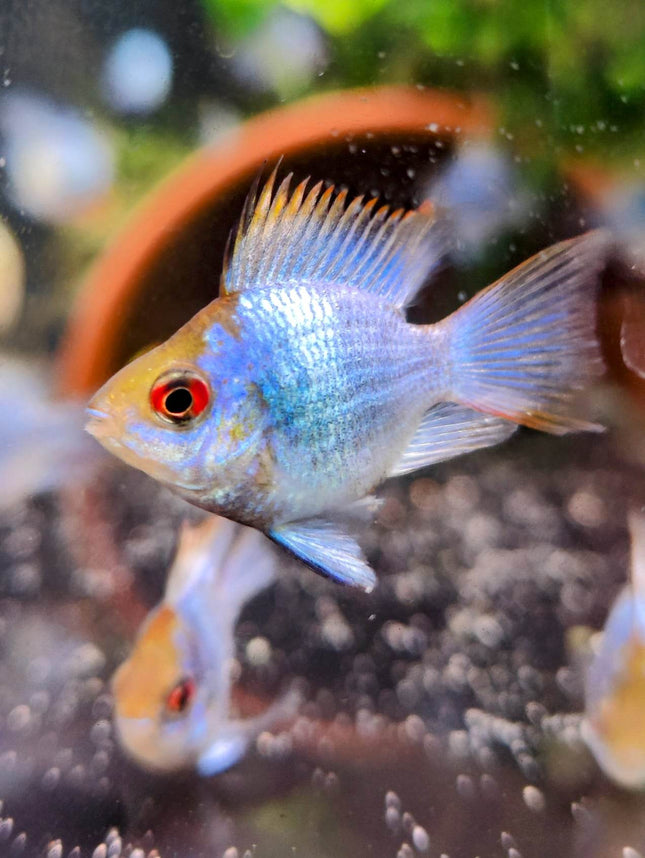
Introducing the mesmerizing German Blue Ram Balloon! 🎈🐠 These unique and eye-catching freshwater fish are a must-have for any aquarium enthusiast. With their rounded body shape and stunning blue coloration, they bring a touch of elegance and charm to your aquatic world. Learn more about their care needs, compatibility, and watch as they gracefully swim through your tank. Dive into the enchanting world of German Blue Ram Balloons today and elevate your aquarium experience to new heights! 🌊💙 Scientific name: Mikrogeophagus ramirezi Common names German blue ram, ram cichlid, blue ram cichlids, German blue, Asian ram, butterfly cichlid, Ramirez's dwarf cichlid, dwarf butterfly cichlid Distribution: South America, Orinoco river basin Size: 2–3 inches Life expectancy: 2–3 years Color: Gold or silver body with blues and black markings Diet: Omnivore Temperament: Peaceful Minimum tank size: 20 gallons Temperature: 80–86°F (26–30°C) pH: 5.0–7.0 Hardness: 6–14 dGH Care level: Intermediate Breeding: Egg layer #GermanBlueRamBalloon #AquariumEnthusiast #MesmerizingAquaticBeauty
$45.00

The Gold Balloon Ram is a selectively bred variant of the German Blue Ram, which itself was selected for being shorter and more stout than its wild counterpart. The balloon variation makes even further changes to this standard body shape with an emphasis on making it taller in order to make room for larger bags of gold held within their trunk-like legs.) Rams, best housed in groups of five or more individuals, enjoy living together within their social group. While they are peaceful towards other fish tank mates like tetras and guppies but will fight amongst themselves to establish a hierarchical order for the group. Because larger groups help spread out any potential fighting between rams it makes the environment easier on everyone involved as opposed to smaller tanks where fights may be intensified due to lack of space/territory being established by one another. Rams prefer aquariums with sand, gravel or mixed substrate along with plenty of plants and driftwood so that they can create their own territory within an aquatic habitat which helps reduce conflicts alone while also creating interesting places throughout your home! Because fish need vitamins and minerals to stay healthy, it is best to feed them a variety of food items. A few ideas are Meaty flakes, mini-pellets, freeze-dried worms or frozen brine shrimp. It's important that they're fed several times per day with no more than five minutes between each feeding session so the tank doesn't get dirty since their waste will cause toxins in the water if not removed quickly enough! Species – Microgeophagus ramirezi Gold Common Name – Gold Blue Balloon Ram Origin – South America Diet – Omnivore PH Range – Acidic 5 – 7 Temperature – Tropical 24°c – 28°c Breed Type – Egg Layer Current Size – approximately 3cm (Grows to approximately 6cm) Sex – Un-sexed
$35.00
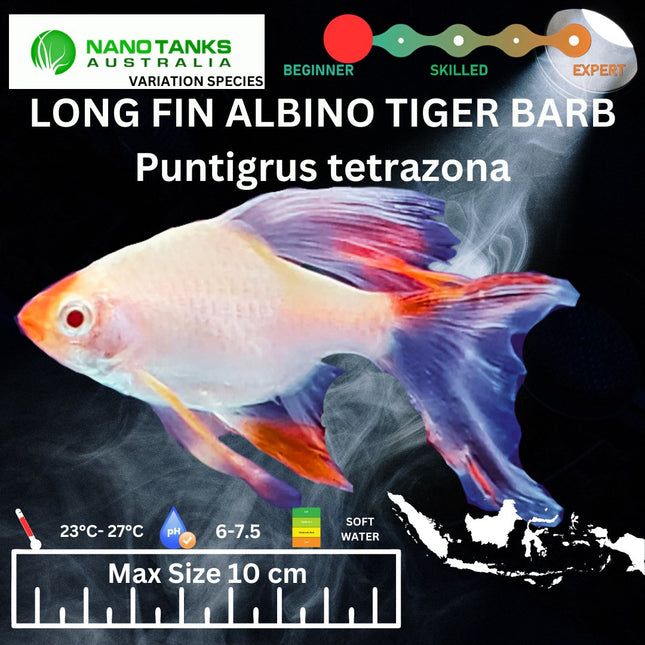
Appearance Tiger Barbs have an iconic look that even novice fish-keepers will instantly recognize. The body of the fish is quite wide. It’s tallest at the middle point and tapers down to a triangular-shaped snout. These fish are also quite colorful and have a very distinct pattern. The base color of Tiger Barbs is usually golden yellow. Some also have subtle rose gold tint. On top of that base color are several stripes. Care Tiger Barb care isn’t too difficult and can be handled by aquarists without much experience (assuming you stick to the recommendations in this guide). Otherwise, they wouldn’t be as widespread as they are! In general, these fish are relatively hardy and can adapt to simple setups as long as you cover the basics. That said, there are some aspects of their care that’ll require a bit of special attention. Despite their small size and beautiful looks, their strong personalities can be a handful! Here are the main care recommendations you need to know. Tank Size The minimum tank size for a small group of Tiger Barbs should be at least 20 gallons. However, we recommend going with a 30-gallon tank if you can. As we mentioned earlier, these fish are avid swimmers. The more room they have, the better. Plus, ample room to swim may help stave off aggressive behavior. Water Parameters In the wild, you can find Tiger Barbs inhabiting lakes, streams, and swamps that are lined with trees. Thanks to the decaying plant matter in the water, conditions tend to be more acidic. For the best results, you need to mimic their natural environment as closely as possible. That includes getting the water conditions just right. Luckily, the Tiger Barb can tolerate a generous range of conditions. As long as you stick within the following ranges, your fish should have no problem staying healthy. Water temperature: 68°F to 82°F degrees (aim for around 74°F if possible) pH levels: 6.0 to 8.0 (a slightly acidic 6.5 is best) Water hardness: 4 to 10 dKH To ensure that the aquarium has the proper water parameters you should invest in a reliable and accurate test kit. This will help you have confidence in the readings you’re getting, allowing you to make the right adjustments when necessary.
$10.00
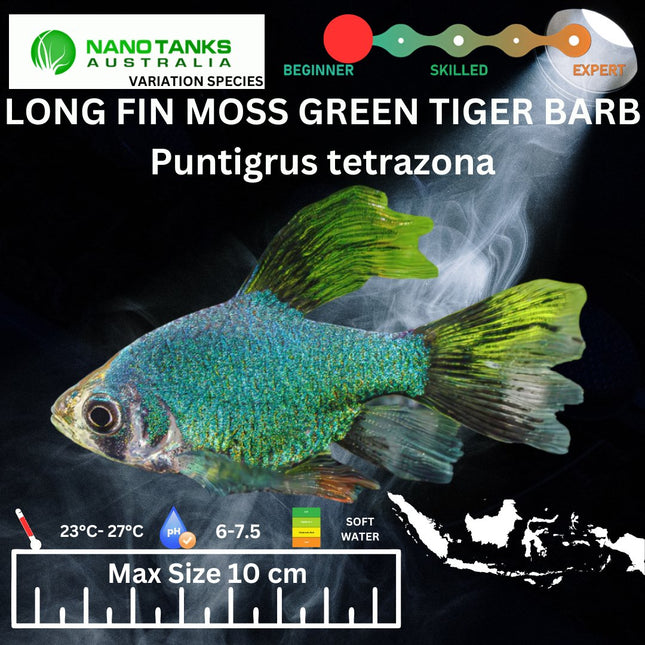
Appearance Tiger Barbs have an iconic look that even novice fish-keepers will instantly recognize. The body of the fish is quite wide. It’s tallest at the middle point and tapers down to a triangular-shaped snout. These fish are also quite colorful and have a very distinct pattern. The base color of Tiger Barbs is usually golden yellow. Some also have subtle rose gold tint. On top of that base color are several stripes. Care Tiger Barb care isn’t too difficult and can be handled by aquarists without much experience (assuming you stick to the recommendations in this guide). Otherwise, they wouldn’t be as widespread as they are! In general, these fish are relatively hardy and can adapt to simple setups as long as you cover the basics. That said, there are some aspects of their care that’ll require a bit of special attention. Despite their small size and beautiful looks, their strong personalities can be a handful! Here are the main care recommendations you need to know. Tank Size The minimum tank size for a small group of Tiger Barbs should be at least 20 gallons. However, we recommend going with a 30-gallon tank if you can. As we mentioned earlier, these fish are avid swimmers. The more room they have, the better. Plus, ample room to swim may help stave off aggressive behavior. Water Parameters In the wild, you can find Tiger Barbs inhabiting lakes, streams, and swamps that are lined with trees. Thanks to the decaying plant matter in the water, conditions tend to be more acidic. For the best results, you need to mimic their natural environment as closely as possible. That includes getting the water conditions just right. Luckily, the Tiger Barb can tolerate a generous range of conditions. As long as you stick within the following ranges, your fish should have no problem staying healthy. Water temperature: 68°F to 82°F degrees (aim for around 74°F if possible) pH levels: 6.0 to 8.0 (a slightly acidic 6.5 is best) Water hardness: 4 to 10 dKH To ensure that the aquarium has the proper water parameters you should invest in a reliable and accurate test kit. This will help you have confidence in the readings you’re getting, allowing you to make the right adjustments when necessary.
$15.00
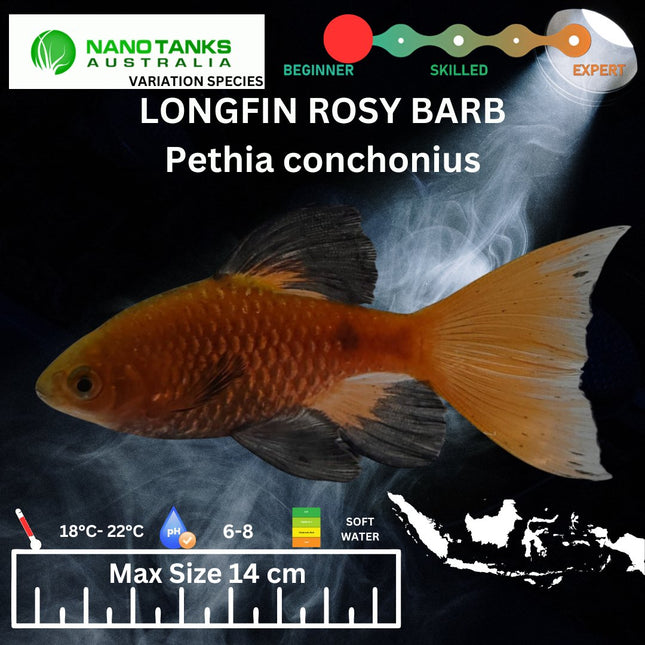
The Long Fin Rosy Barb is a variety of the Rosy Barb, a popular and active freshwater aquarium fish. As its name suggests, this variety of Rosy Barb has longer and more flowing fins than the standard Rosy Barb, which adds to its visual appeal. Long Fin Rosy Barbs are generally peaceful and hardy, making them a good choice for beginner aquarists. They are active swimmers and require plenty of swimming space, so a minimum tank size of 30 gallons is recommended. They prefer slightly acidic to neutral water with a pH range of 6.0-7.5 and a temperature range of 72-82°F (22-28°C). They are omnivorous and will eat a variety of foods, including flakes, pellets, frozen or live foods, and even vegetables. These fish are known to be social and can be kept in groups of six or more. In a group, they will often swim and play together, and will even form a hierarchy based on size and dominance. They are relatively adaptable to a range of water conditions, but it's important to maintain good water quality and provide plenty of hiding places and open swimming areas in the tank. The Long Fin Rosy Barb can grow up to 4 inches (10 cm) in length, and the long fins of the males can add an additional 1-2 inches (2.5-5 cm) to their overall length. These fish are known to be active and playful, and can sometimes be a bit nippy, especially towards slow-moving or long-finned fish. It's important to provide plenty of hiding places and open swimming areas in the tank, as well as plenty of food to prevent aggression. Overall, the Long Fin Rosy Barb is a popular and visually striking variety of the Rosy Barb that is relatively easy to care for and can add a unique and playful element to a community aquarium. Thank you to CK Yeo for the image.. Please advise if you like the image removed.
$9.00
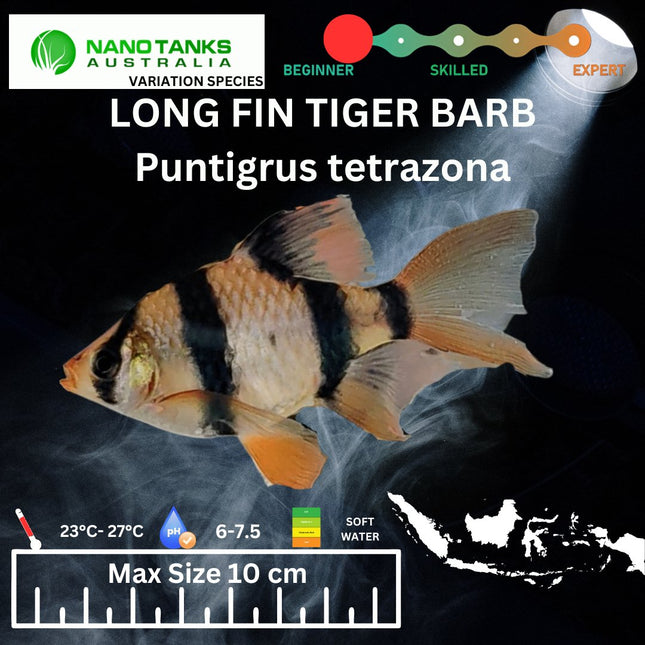
Appearance Tiger Barbs have an iconic look that even novice fish-keepers will instantly recognize. The body of the fish is quite wide. It’s tallest at the middle point and tapers down to a triangular-shaped snout. These fish are also quite colorful and have a very distinct pattern. The base color of Tiger Barbs is usually golden yellow. Some also have subtle rose gold tint. On top of that base color are several stripes. Care Tiger Barb care isn’t too difficult and can be handled by aquarists without much experience (assuming you stick to the recommendations in this guide). Otherwise, they wouldn’t be as widespread as they are! In general, these fish are relatively hardy and can adapt to simple setups as long as you cover the basics. That said, there are some aspects of their care that’ll require a bit of special attention. Despite their small size and beautiful looks, their strong personalities can be a handful! Here are the main care recommendations you need to know. Tank Size The minimum tank size for a small group of Tiger Barbs should be at least 20 gallons. However, we recommend going with a 30-gallon tank if you can. As we mentioned earlier, these fish are avid swimmers. The more room they have, the better. Plus, ample room to swim may help stave off aggressive behavior. Water Parameters In the wild, you can find Tiger Barbs inhabiting lakes, streams, and swamps that are lined with trees. Thanks to the decaying plant matter in the water, conditions tend to be more acidic. For the best results, you need to mimic their natural environment as closely as possible. That includes getting the water conditions just right. Luckily, the Tiger Barb can tolerate a generous range of conditions. As long as you stick within the following ranges, your fish should have no problem staying healthy. Water temperature: 68°F to 82°F degrees (aim for around 74°F if possible) pH levels: 6.0 to 8.0 (a slightly acidic 6.5 is best) Water hardness: 4 to 10 dKH To ensure that the aquarium has the proper water parameters you should invest in a reliable and accurate test kit. This will help you have confidence in the readings you’re getting, allowing you to make the right adjustments when necessary.
$10.00

General care for shrimp: Temperature:18°-24°C Chlorine/chloramines: 0 ppm (very toxic for shrimp) Ammonia/Nitrite: 0 ppm. Nitrate: <20 ppm. pH: 6.2-7.5. GH: 4-8 dGH KH: 3-15 dKH Name Optimal TDS Limits Cherry shrimp 150 – 200 100 – 400 Cardinal shrimp 100 50 – 150 Tiger shrimp 180 – 220 100 – 300 We strongly recommend to drip acclimate any shrimp untill the TDS matches before you release the shrimp into your tank. Please note the above is just a general indication of the care requirements of shrimp. Results will vary depending on the individuals set up. NO SHIPPING TO WA
$15.00 - $20.00

Ludwigia Glandulosa Scientific name: Ludwigia glandulosa Family: Onagraceae Usual maximum size in aquariums: 15 - 40 cm (5.91 - 15.75 inch) Recommended pH range for the species: 6 - 7.2 Recommended water hardness (dGH): 4 - 12°N (71.43 - 214.29ppm) Recommended temperature: 20 - 28 °C (68 - 82.4°F) Reproduction of the plant: Cuttings Origin (in the wild): North America How fast these plants grow: Slow Recommended substrate: Fine gravel Demands on lighting: Bright Ideal placement in a fish tank: Background
$9.95

Variety of Ludwigia repens from North America with striking dark red leaves and stalk. Stems from 20-50 cm and 4-6 cm wide. It provides a great colour contrast to the green shades in the aquarium. Plant in large groups to enhance the decorative effect and prune regularly to encourage bushy growth.The plant has few demands, but if the light is insufficient the lower leaves tend to fall off. In strong light, the colour becomes more intense.
$10.00

Ludwigia sp. 'Super Red' is a new Ludwigia species that assumes an intensively red color even under medium light. It ramifies well and is rather undemanding. It was brought onto the market under several names. This plant look similar to Ludwigia "Rubin" that develops larger leaves, the different between Ludwigia sp. 'Super Red' and Ludwigia Rubin is Ludwigia sp. 'Super Red' has thinner leaves. Ludwigia sp. 'Super Red' will do best in rich nutrient substrate, high lighting and CO2 injected aquarium.
$10.00

The Lyretail Guppy Male is a type of guppy fish that is known for its spectacularly colorful tail. Its tail is shaped like a lyre, hence its name. It is one of the most popular guppy varieties due to its bright and vibrant colors. The Lyretail Guppy Male is a hardy fish and is easy to care for in captivity. It is a peaceful fish that does well in a community aquarium. It can be kept with other non-aggressive fish of the same size and is an ideal choice for beginner aquarists. The Lyretail Guppy Male can grow to a maximum size of 1.5 inches and can live for up to five years in captivity.
$6.00
General information: It is one of the smaller River Prawns restricted to fresh water. It is reported to grow to 63mm but specimens in captivity can grow larger. Females are slightly smaller than males and appear to have smaller claws. It is found in permanent streams and mostly in vegetation in areas of noticeable flow. It appears to prefer well oxygenated clean water and has not been collected by Aquagreen in any billabongs or places where the water is stagnant. Cultivation notes : This species is less tolerant of poor water quality and thus a little harder to keep than Macrobrachium bullatum. They do well in an aquarium that has harder water and with plenty of water flow. The females have larger and fewer eggs than other Macrobrachium. They will breed in the aquarium if there is plenty of cover. It is not known for any snail eating capability as their cousins the M. bullatum. In captivity they seem to eat most prepared foods that get past the fish. They mostly stay hidden in the daylight sometimes coming out for feeding. They are out and about in the aquarium when the lights are out. The average water quality for the aquariums and ponds where they are raised is temperature of 26 to 30, pH 7 to 7.8, Hardness 40 to 100 ppm, Carbonate hardness 50 to 110 ppm. the ponds where they are raised are well aerated, they do not survive in a still pond for very long. The rivers where thay occur can have much harder water. The Daly River water quality is available on the ANGFA database. Distribution : Southern New Guinea and Northern Australia from the Victoria River in the NT across to the Norman River in Qld. Selling details : Sold individually at 2.5 cm or larger Reference: John Short (2000) A revision of Australian river prawns, Macrobrachium (Crustacea: Decapoda: Palaemonidae)
$100.00
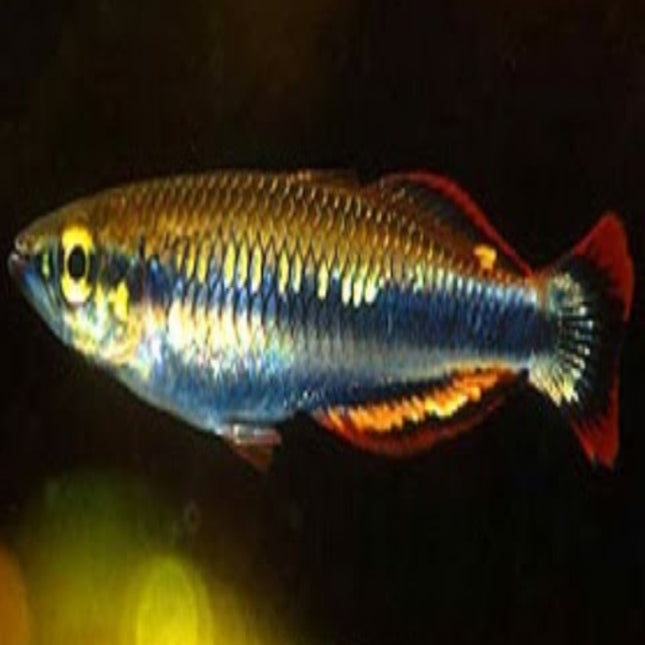
Distribution Known only from small streams and the lower reaches of rivers, most of which drain into a series of coastal lagoons and lakes in Atsinanana region, eastern Madagascar. Although the extent of its historical range is unclear, modern distribution extends southwards from the lower Ivoloina River, just north of Toamasina city, as far as Manambalo Creek which lies south of the town of Vatomandry. The lakes and rivers along this stretch of coastline are connected by the Canal des Pangalanes, an artificial waterway constructed to allow boat transport throughout the natural lake system. It’s the longest man-made canal in the world, extending for some 600 km. South of Manambalo Creek and in the middle and upper Ivoloina River this species is replaced by undescribed members of the genus, in middle and upper sections of rivers within the boundaries of its range by B. leucopteron, and north of the Ivoloina by B. longianalis. Habitat Inhabits clear, flowing streams at altitudes up to 30 m AMSL, and shows a preference for habitats partially or completely shaded by riparian vegetation where water flow is not too strong. All habitats are characterised by extremely soft freshwater, and it has also been collected from blackwater swamp habitats with low pH and tannin-stained water. In unshaded or turbid environments it’s replaced by introduced Gambusia holbrooki and Xiphophorus maculatus. Young specimens have been observed to congregate in shallow, marginal zones with adults preferring deeper water, and is normally found in groups of ‘up to several dozen’ (Loiselle and Rodriguez, 2007). The species is also fished for food across the majority of its range. Maximum Standard Length 80 – 100 mm. Water Conditions Temperature: A range of 23 – 32 °C has been recorded in its natural waters during a single month. pH: 4.5 – 7.5. Wild specimens are likely to require more acidic water then farmed fish. Hardness: 0 – 268 ppm
$20.00
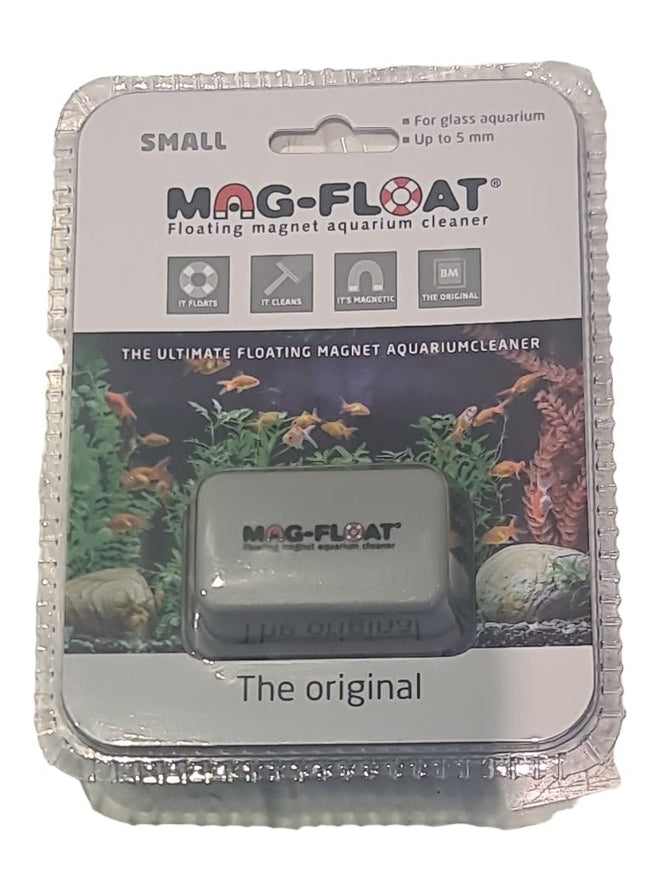
If you're looking for a convenient and effective way to clean your aquarium without getting your hands wet, the Mag-Float Small is the perfect solution. This floating magnetic cleaner is designed to remove algae and other debris from the surface of your aquarium glass quickly and easily, making it a must-have for any aquarium owner. Its compact size makes it suitable for smaller aquariums, and its powerful magnets ensure a thorough cleaning without scratching the glass. Shop now for the Mag-Float Small and keep your aquarium looking its best with minimal effort.
$35.95

Suitable for glass & acrylic aquariums up to 3mm thickness.
$20.95

A magnetic brush for aquarium glass cleaning is a device used to clean the interior surfaces of aquariums without the need to submerge one's hand or arm in the water. The brush consists of two parts: a scrubber that is placed inside the tank, and a handle that is used to move the scrubber from outside the tank. The scrubber and the handle are held together by strong magnets. The scrubber is designed to be lightweight and gentle enough to avoid scratching the aquarium glass or damaging any decorations or living organisms in the tank. The handle is typically made of a durable, waterproof material, such as plastic or rubber, to withstand the wet environment of the aquarium. To use the magnetic brush, the scrubber is placed inside the tank and moved around the interior glass surfaces. As the scrubber moves, the handle outside the tank moves along with it, thanks to the magnets. The user can then clean the glass by moving the handle back and forth, applying light pressure to the scrubber. One advantage of a magnetic brush for aquarium glass cleaning is that it can be used on thick glass or acrylic aquariums, which can be difficult to clean with traditional aquarium cleaning tools. The magnetic brush can also reach tight spaces and corners that are hard to access by hand or with other cleaning tools. Overall, a magnetic brush for aquarium glass cleaning is a useful tool for aquarium maintenance that can make the cleaning process easier and more efficient. It is a safe and effective method for cleaning aquarium glass, while minimizing the amount of water that needs to be removed from the tank for maintenance.
$30.95

General information: It varies in colour from pale green in the shade to deep maroon in the full sun. It is usually found in water less than 50 cm deep. Often found in non-permanent creeks where it multiples to a large amount just before the creek dries. Aquagreen has two forms under cultivation, a thin leafed variety and one with slightly broader more straight leaves. Cultivation notes : Maidinea is related to Vallisneria and has similar propagation habits, it multiplies itself by runners across the bottom when conditions are good. It can also be propagated by planting cut stems, runners can start well up the stem from the substrate. Maidenia is easy to cultivate in the aquarium with CO2 pH control and bright light. Best kept in a very warm aquarium with the temperature between 27 and 30 deg C. When the temperature drops below about 22 deg it rots off at the base and floats for a while before dying. In nature it is an annual but in the aquarium with the steady light period and temperature it grows all year. Distribution : Endemic to the tropical areas of NT and WA. Selling details : sold by bunch of cut stems tied at the base. Reference: Cowie, Short, Osterkamp Madsen (2000) "Floodplain Flora, a flora of the floodplain of the Northern Territory, Australia"
$10.00

The Malaysian Driftwood is a staple in the Aquarium industry for many years. They come in great shapes and sizes and they are great for those looking for something that is easy to use. It provides a simple and natural look to any freshwater aquariums. Creating an ideal environment for any tank. The uniqueness of each shape is absolutely stunning and when you come to the shop or get it shipped out be assured that you will get some very nice unique pieces. What is Malaysian driftwood? Malaysian Driftwood is naturally grown in Malaysia. The most widely popular wood comes from the tree Diospyros Ebonasea. These types of trees are naturally a perennial plant. Ebonasea is part of the genus Diospyros which is a group of dark woods also typically referred to as Ebony. Where is Malaysian driftwood from? Naturally occurring in Malaysia How do you get Driftwood to sink? This type of driftwood is also naturally denser then water and will sink. However, there are times that the wood is lighter then water and will float. However giving it a few weeks it will get water logged and will sink. Is Malaysian Driftwood safe for aquarium? Malaysian Driftwood is completely safe for the aquarium. However, like anything else it is advisable that you rinse the wood before putting it into the aquarium. How long do you soak Malaysian driftwood? Naturally you do not need to soak Malaysian Driftwood as it will sink. Does Malaysian driftwood lower pH? Malaysian Driftwood will lower pH.
$50.00 $35.00

Marina Floating 2 in 1 Fish Hatchery - Separation Box The Marina 2-in-1 Floating Fish Hatchery is ideal for breeding and raising fish in community aquariums. A safe floating haven for live-bearing fish and fry, it has two separate areas for expectant fish and segregated bottom compartments that safely collect and protect falling fry. The hatchery has a centre divider that allows you to keep two pregnant fish at once. The Fish Hatchery can also be used as a safe-house for wounded fish or to segregate aggressive fish. Easy to Assemble Multiple options Ideal isolation chamber for pregnant fish Provides a safe haven for weak or sick fish Floats on the surface of the water Suitable for fresh or salt water use Overall Dimensions(LxWxH): 20.5cm x 10cm x 10cmInner Dimensions (LxWxH): 16cm x 10cm x 10cm Marina item number - 10931
$14.95

Marina 3 in 1 Breeding Trap - Separation Box The Marina 3-in-1 Floating Breeding Trap comes with all the accessories for an all-in-one, self-contained live-bearer breeding tank. A safe floating haven for live-bearing fish and fry, it has a chamber for expectant fish and a V-shaped bottom compartment that safely collects and protects falling fry. It can also be used as a betta fish enclosure as well as for segregating sick or aggressive fish. Easy to Assemble Multiple options Ideal isolation chamber for pregnant fish Provides a safe haven for weak or sick fish Floats on the surface of the water Suitable for fresh or salt water use Trap Lid is included Overall Dimensions (LxWxH): 16cm x 8cm x 8cmInner Dimensions (LxWxH): 13cm x 8cm x 8cm Marina item number - 10933
$12.95

Bettas naturally seek out leaves to rest and conserve their energy. The Marina Betta Pad provides a safe, non-toxic environment and will also promote bubble nesting which is a sign of a healthy and happy fish. Key Features : Made from safe, fade-resistant material Includes suction cup
$7.95

Marina Fish Net Breeder - Separation Box Marina Fish Net Breeder provides an ideal isolation chamber for sick or weak fish. The fine mesh netting allows free flow of water to keep oxygen levels up. It can also be used as a floating safety chamber for pregnant livebearers, wounded or aggressive fish. Easy to Assemble Box measurements Ideal isolation chamber for pregnant fish Provides a safe haven for weak or sick fish Adjust metal tabs to fit the sides of the tank Suitable for fresh or salt water use Dimensions (LxWxH): 16.5cm x 12.5cm x 13cm Marina item number - 10934
$9.95

Marsilea hirsuta is a carpet-plant from Australia. A fascinating plant, usually delivered with leaves like a four-leaf clover. After a transitional period it develops different types of leaves, possibly a low form with single leaves like a large Glossostigma, or alternatively develop two, three or four-lobed leaves varying in height (from 2-10 cm), depending on the growth conditions. Whichever form the plant adopts, it forms runners and spreads rapidly round the aquarium.
$10.00
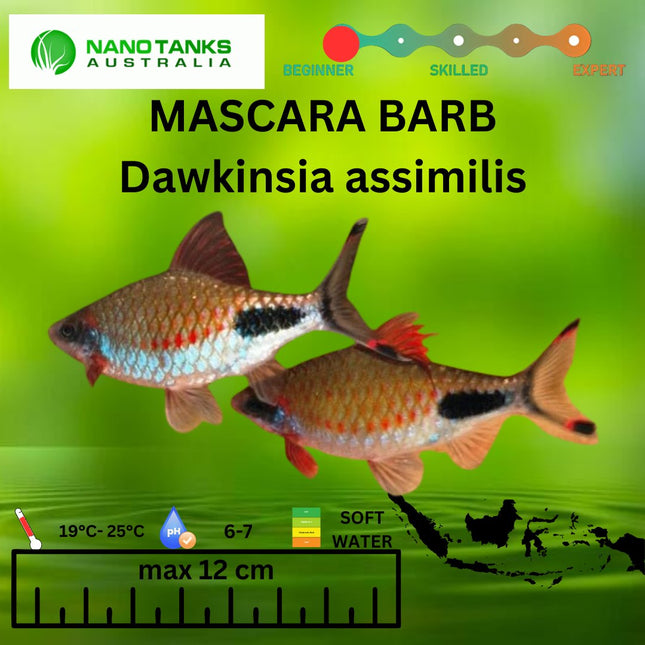
The Mascara barb (dawkinsia assimilis) One of the more peaceful barbs available, unfortunately its a rare specimen here in Australia. like most barbs, it is ideal to keep them in groups of 8+ to reduce nipping and aggression. the mascara barb will grow up to a max size of 12cm.
$40.00

Master Soil is a type of high-quality substrate used in aquariums and planted tanks. It is designed to provide essential nutrients to aquatic plants and promote healthy root growth. The substrate is made from a special blend of natural minerals and organic matter that helps to maintain a stable pH level in the tank. Master Soil is also known for its ability to improve water quality by absorbing harmful substances and preventing the growth of algae. It is a popular choice among aquarium hobbyists who want to create a healthy and thriving aquatic environment for their fish and plants.
$29.95

Master Soil 8L is a premium soil mix that is ideal for growing fruits and vegetables in containers. It is made from a combination of high-quality organic ingredients, including worm castings, bat guano, kelp meal, and peat moss. The mix is designed to provide plants with the optimum balance of air, water, and nutrients, creating an environment that encourages healthy root development and vigorous growth. It is a lightweight and well-draining soil that is perfect for container aquscapes.
$49.95

Tenebrio Molitor species 50gm Mealworms. Packed in a plastic tub with bran, paper and carrot. OTHER MEALWORM SIZES: Mini mealworms and Superworms (although these are a different species) OTHER MEALWORM SIZES: Mini mealworms and Superworms (although these are a different species) MEALWORM CARE: Mealworms are easy to keep in a plastic container with small holes. We ship them to you with bran, which they use for bedding and food. They are best kept in the fridge and will live happily there for a number of weeks. They slow down considerably when kept in the fridge, but still need to be fed. About every two weeks add a few small pieces of carrot which they will eat and use as a source of moisture. If left out of the fridge the worms will begin to pupate and are much less palatable. Mealworms should be considered a "treat food" as they are high in fat and have a hard exoskeleton that can cause issues with some animals. They are a good addition as part of a well-balanced diet. WHO LOVES OUR MEALWORMS? Mealworms are a great food for lizards and are a favourite of Bearded Dragons, frogs, turtles and amphibians, spiders and scorpions, fish, birds including insectivores, magpies, finches and chooks will love you for them too. TRIED THOSE, WHAT ELSE HAVE YOU GOT? If you want to vary the diet of your beloved critter you might want to try some Black Soldier Fly Larvae, crickets, superworms or silkworms. A little of this and a little of that keep your pet interested and offer different hunting opportunities to keep them stimulated.
$14.00

The dwarf rainbowfish (Melanotaenia praecox) is a species of rainbowfish in the subfamily Melanotaeniinae, also commonly known as the neon rainbowfish. It is endemic to the Mamberamo River basin in West Papua in Indonesia and common in the aquarium trade. Males tend to be brighter in color and have deeper bodies than the females. This species' is considered to be an egg-scatterer, so it is easy to breed.Their bodies are bright blue and iridescent, and their fins are colorful. This species is active and is known to jump out of water. They are native to a tropical climate. Wikipedia contributors. (2019, September 9). Dwarf rainbowfish. In Wikipedia, The Free Encyclopedia. Retrieved 03:52, October 19, 2019, from https://en.wikipedia.org/w/index.php?title=Dwarf_rainbowfish&oldid=914808380 Picture: http://www.tropical-fish-keeping.com/wp-content/uploads/2015/06/Praecox-Rainbowfish-Melanotaenia-praecox.jpg
$33.00 - $35.00
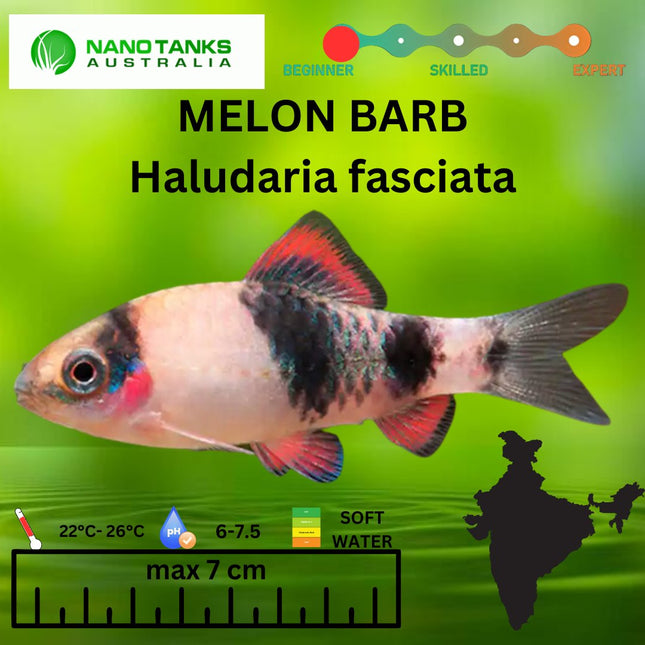
Melon Barbs is a tropical fish native to India. It is a beautiful fish with a distinctive orange and yellow body, adorned with black spots and markings. This fish grows up to 7 cm in length, and its body shape is cylindrical with a slightly pointed head. The dorsal fin is long and pointed, while the tail fin is slightly forked. This fish is an active swimmer and prefers to dwell in the middle of the tank. It is an omnivore and will happily accept a variety of foods, including flakes, pellets, live, frozen, and freeze-dried foods. It is a peaceful fish that prefers to be kept in small groups, and it is a great addition to any community tank. FISH KEEPING SNAPSHOT : Keeping Difficulty : Beginner Diet : Omnivore Temperament : Peaceful Max Size : 7cm PREFERRED WATER PARAMETERS : Water Temperature : 22-26 ⁰C pH Level :6.0-7.5 General Hardness : Soft-Moderate (50 - 150ppm)
$12.00 - $60.00
$30.00
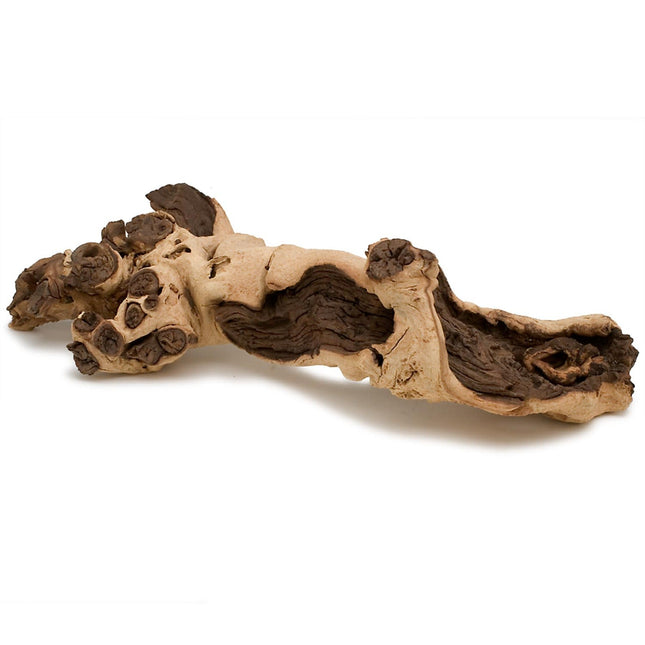
Micro Mopani Wood Nano Aquascape is a type of aquascape designed for small tanks. It features Mopani wood and a variety of nano-sized plants to create an aesthetically pleasing and natural environment. The wood provides a natural look, as well as a structure for the plants to grow, while the combination of small plants creates depth and texture. This type of aquascape is perfect for small tanks, as it has a low-maintenance requirement, and will make a great addition to any aquarium.
$9.95 $5.00
You have seen 792 out of 1935 products